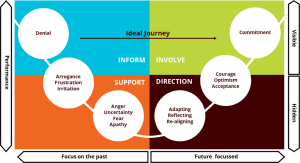
Minimising the impact of the striking university staff
The impact of the striking university staff grows and the stage looks set for months of disruption, anger and costly polarised positions.
The possible consequences are stark: an alternative valuation of the pension scheme, up to 115,000 students putting in compensation claims to their university for lack of tuition, students being blacklegged for not showing solidarity to lecturers, even claims from students against individual lecturers are possible. Not to mention of course the staff themselves, who typically face losing £10,000 p.a. pension income with younger academics losing almost 50%.
Despite this, we are where we are and both sides appear to be standing firm. Given that the decision was not undertaken lightly and was always likely to be explosive, how could it have been managed differently? Could it have been done in a way that avoids the current fallout? How much has the emotional dimension been addressed in all this?
In any change there is the rational and the emotional.
In this situation the rational, financial case has been well made – the pension scheme had a deficit of £6bn and the employer (Universities UK) has a legal duty to put in place a credible plan to reduce the deficit by this summer. Even after the changes the scheme stacks up well against other pensions, with employer contributions double the private sector average. Everyone concerned has had access to all the key information.
I imagine that for some the rational argument is enough, the change is disappointing but inevitable and they will move on.
But not for all. Some will be stuck way back on the change curve experiencing anger, blame or denial. Without addressing the emotions, the rational doesn’t cut much ice. In fact, if the emotions are not addressed they tend to get stronger.
So, what can leaders and managers of all those affected do to manage this charged situation effectively?
“Instead of resisting any emotion, the best way to dispel it is to enter it fully, embrace it and see through your resistance.” – Deepak Chopra
Strong feelings can be scary – we don’t know where they might lead or what decisions or behaviour they might drive. But avoiding feeling generally creates more and bigger problems. This is where emotional intelligence comes in. Being more aware, confident, smarter and intentional with feelings.
At Pecan we use an approach called People Engaged Change which takes into account the rational and emotional dimensions and addresses both to successfully implement change.
Below is one of the tools that clients find extremely useful in enabling leaders to manage themselves and lead others through change. As with all good tools, it is simple to understand and only becomes powerful when applied correctly.

Use the tool to open up discussion and create common language, as a map to explore the emotional landscape and then identify what will make most difference in navigating the change curve as quickly as possible.
Going back to the striking lecturers, I would hazard a guess that they may not have had an opportunity to share how they feel about the change (bottom left quadrant) and once they have got some of it off their chest, they will be able to start to engage with the future (bottom right). The first and most cathartic thing might be for them to have a damn good listening to.
This takes appetite, time and care. It may be challenging and may not be a simple and quick process. However, time and attention invested will be much appreciated and will help everyone adapt and start to move on. It also starts to increase the level of EQ and build resilience for ongoing change. Welcome to the world of emotional intelligence!
I’d welcome any feedback on this approach so please share your experience of navigating change or getting more EQ into your organisation. Let us know if you would like any further information [email protected].
Image: Morgan Basham, unsplash.com
